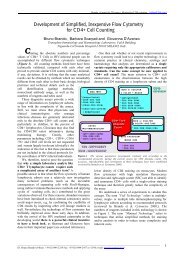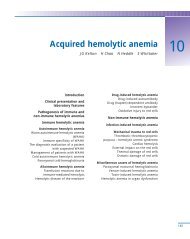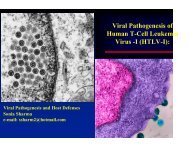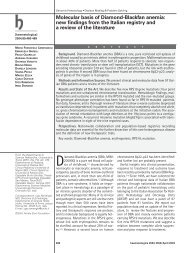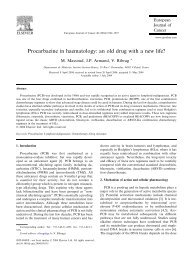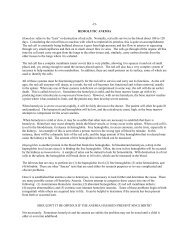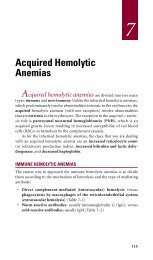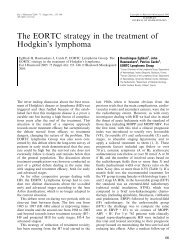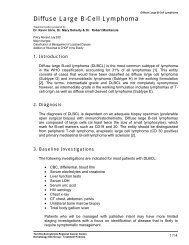Hemolytic Anemia
Hemolytic Anemia
Hemolytic Anemia
- No tags were found...
You also want an ePaper? Increase the reach of your titles
YUMPU automatically turns print PDFs into web optimized ePapers that Google loves.
shunts, can induce MAHA. 15<br />
INFECTION<br />
Numerous mechanisms link infection and hemolysis. 16<br />
Autoantibody induction (e.g., by M. pneumoniae), glucose-<br />
6-phosphate dehydrogenase (G6PD) deficiency, and antimicrobial<br />
drugs (e.g., penicillin) are discussed elsewhere in this<br />
article. In addition, certain infectious agents are directly<br />
toxic to red blood cells.<br />
Malaria is the classic example of direct red blood cell<br />
parasitization. Plasmodium species, introduced by the Anopheles<br />
mosquito, invade red blood cells and initiate a cycle of<br />
cell lysis and further parasitization. Both the cellular invasion<br />
and the metabolic activity of the parasite alter the cell<br />
membrane, leading to splenic sequestration. 16,17 Red cell lysis<br />
also contributes to the anemia and can be dramatic in the<br />
case of “blackwater fever,” named for the brisk intravascular<br />
hemolysis and hemoglobinuria that accompany overwhelming<br />
Plasmodium falciparum infection. The diagnosis is made<br />
by the observation of intracellular asexual forms of the<br />
parasite on thick and thin blood smears.<br />
Similarly, Babesia microti and Babesia divergens, tick-borne<br />
protozoa, and Bartonella bacilliformis, a gram-negative bacillus<br />
transmitted by the sandfly, cause extravascular hemolysis by<br />
direct red blood cell invasion and membrane alteration.<br />
Septicemia caused by Clostridium perfringens, which occurs<br />
in intra-abdominal infections and septic abortions, causes<br />
The Authors<br />
GURPREET DHALIWAL, M.D., is assistant clinical professor of medicine<br />
at the University of California–San Francisco School of Medicine. He<br />
graduated from Northwestern University Medical School, Chicago, and<br />
completed a residency in internal medicine at the University of California–San<br />
Francisco School of Medicine, where he was chief resident.<br />
PATRICIA A. CORNETT, M.D., is clinical professor of medicine at the University<br />
of California–San Francisco School of Medicine. She graduated<br />
from the Medical College of Pennsylvania, Philadelphia, and completed a<br />
residency in internal medicine and a fellowship in hematology/oncology<br />
at Letterman Army Medical Center, San Francisco.<br />
LAWRENCE M. TIERNEY, JR., M.D., is professor of medicine at the University<br />
of California–San Francisco School of Medicine. He graduated from<br />
the University of Maryland School of Medicine, Baltimore, and completed<br />
an internal medicine residency at the University of California–San<br />
Francisco School of Medicine, where he was chief resident.<br />
Address correspondence to Gurpreet Dhaliwal, M.D., San Francisco Veterans<br />
Affairs Medical Center, 4150 Clement St. (111), San Francisco, CA<br />
94121 (e-mail: gurpreet.dhaliwal@med.va.gov). Reprints are not available<br />
from the authors.<br />
FIGURE 4. Schistocytes (arrows).<br />
Reprinted with permission from Maedel L, Sommer S. Morphologic<br />
changes in erythrocytes. Vol. 4. Chicago: American Society for Clinical<br />
Pathology Press, 1993:Slide 52.<br />
hemolysis when the bacterium releases alpha toxin, a phospholipase<br />
that degrades the red blood cell membrane.<br />
Hereditary Disorders<br />
The mature red blood cell, while biochemically complex,<br />
is a relatively simple cell that has extruded its nucleus,<br />
organelles, and protein-synthesizing machinery. Defects in<br />
any of the remaining components—enzymes, membrane, and<br />
hemoglobin—can lead to hemolysis.<br />
ENZYMOPATHIES<br />
The most common enzymopathy causing hemolysis is<br />
G6PD deficiency. G6PD is a critical enzyme in the production<br />
of glutathione, which defends red cell proteins<br />
(particularly hemoglobin) against oxidative damage. This<br />
X-linked disorder predominantly affects men. More than<br />
300 G6PD variants exist worldwide, but only a minority<br />
cause hemolysis. 18<br />
Most patients have no clinical or laboratory evidence of<br />
ongoing hemolysis until an event—infection, drug reaction<br />
(Table 3), 19 or ingestion of fava beans—causes oxidative damage<br />
to hemoglobin. The oxidized and denatured hemoglobin<br />
cross-links and precipitates intracellularly, forming inclusions<br />
that are identified as Heinz bodies on the supravital stain<br />
of the peripheral smear. Heinz bodies are removed in the spleen,<br />
leaving erythrocytes with a missing section of cytoplasm;<br />
these “bite cells” can be seen on the routine blood smear. The<br />
altered erythrocytes undergo both intravascular and extravascular<br />
destruction. Older red blood cells are most suscep-<br />
2604-AMERICAN FAMILY PHYSICIAN www.aafp.org/afp VOLUME 69, NUMBER 11 / JUNE 1, 2004



